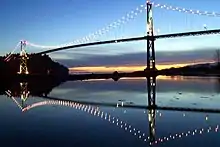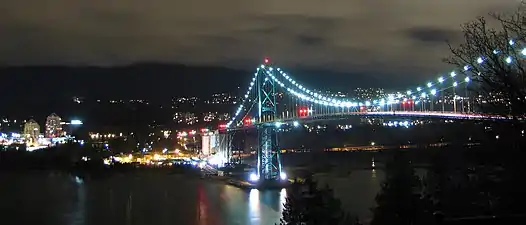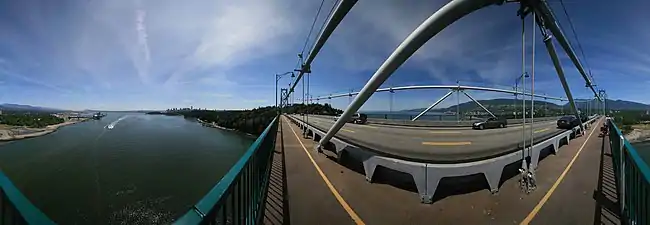Lions Gate Bridge
The Lions Gate Bridge, opened in 1938 and officially known as the First Narrows Bridge,[1] is a suspension bridge that crosses the first narrows of Burrard Inlet and connects the City of Vancouver, British Columbia, to the North Shore municipalities of the District of North Vancouver, the City of North Vancouver, and West Vancouver. The term "Lions Gate" refers to the Lions, a pair of mountain peaks north of Vancouver. Northbound traffic on the bridge heads in their general direction. A pair of cast concrete lions, designed by sculptor Charles Marega, were placed on either side of the south approach to the bridge in January 1939.[2]
Lions Gate Bridge | |
|---|---|
 | |
| Coordinates | 49°18′55″N 123°8′18″W |
| Carries | Three lanes of British Columbia Highway 1A/99, pedestrians and bicycles |
| Crosses | Burrard Inlet |
| Locale | |
| Official name | First Narrows Bridge |
| Maintained by | British Columbia Ministry of Transportation |
| Characteristics | |
| Design | Suspension bridge |
| Total length | 1,823 m (5,981 ft) |
| Height | 111 m (364 ft) |
| Longest span | 473 m (1,552 ft) |
| Load limit | 13 tonnes (12.8 long tons; 14.3 short tons) |
| Clearance below | 61 m (200 ft) |
| History | |
| Designer | Charles Nicholas Monsarrat Philip Louis Pratley |
| Construction start | March 31, 1937 |
| Opened | November 14, 1938 |
| Statistics | |
| Daily traffic | 60,000–70,000 |
| Official name | Lions Gate Bridge National Historic Site of Canada |
| Designated | 24 March 2005 |
| Reference no. | 11711 |
| Location | |

| |
The total length of the bridge including the north viaduct is 1,823 metres (5,981 ft). The length including approach spans is 1,517.3 metres (4,978 ft), the main span alone is 473 metres (1,552 ft), the tower height is 111 metres (364 ft), and it has a ship's clearance of 61 metres (200 ft). Prospect Point in Stanley Park offered a good high south end to the bridge, but the low flat delta land to the north required construction of the extensive North Viaduct.
The bridge has three reversible lanes, the use of which is indicated by signals. The centre lane changes direction to accommodate for traffic patterns. The traffic volume on the bridge is 60,000–70,000 vehicles per day. Trucks exceeding 13 tonnes (12.8 long tons; 14.3 short tons) are prohibited, as are vehicles using studded tires. The bridge forms part of Highways 99 and 1A.
On March 24, 2005, the Lions Gate Bridge was designated a National Historic Site of Canada.[3]
History
In 1890, land speculator George Grant Mackay wrote in the local paper that he foresaw a bridge over the first narrows.[4] The decision on whether to build the bridge was put to the electorate of Vancouver in 1927, but the first plebiscite was defeated and the idea was put to rest for the time being.[5]
Alfred James Towle Taylor, an engineer with a land interest in the construction of the bridge, worked to overcome local opposition to its construction.[6] Taylor was able to convince the Guinness family (of the Irish stout fame) to invest in the land on the north shore of Burrard Inlet. They purchased 1,902 hectares (4,700 acres) of West Vancouver mountainside through a syndicate called British Pacific Properties Ltd.[7][8]
.jpg.webp)
On December 13, 1933, a second plebiscite was held, passing with 70 percent in favour.[9][10] After considerable further negotiations with the federal government, approval was finally granted, with the requirement that Vancouver materials and workmen be used as much as possible to provide employment during the Great Depression. The 1933 bylaw authorizing construction included a provision mandating that "no Asiatic person shall be employed in or upon any part of the undertaking or other works".[11]
The bridge was designed by the Montreal firm Monsarrat and Pratley, which was later responsible for the Angus L. Macdonald Bridge in Halifax, Nova Scotia, using a similar design.[12] Other companies involved in the construction of the bridge included Swan Wooster Engineering, Parsons Brinckerhoff Quade & Douglas, Rowan Williams Davies & Irwin Inc., Canron Western Constructors, Dominion Bridge Company, American Bridge Company.[13]

Construction began on March 31, 1937. After one and a half years and a cost of CA$5,873,837.17 , the bridge opened to traffic on November 14, 1938.[14] On May 29, 1939, King George VI and Queen Elizabeth presided over the official opening during a royal visit to Canada.[15][16] A toll of 25 cents was charged for each car or horse and carriage; five cents was charged for pedestrians or bicycles.[17]
On January 20, 1955, the Guinness family sold the bridge to the province of British Columbia for $5,873,837.17 – the cost of the original construction.[18] The newly constructed bridge differed from the current configuration of the bridge as it originally had only two lanes. Yet, as had been foreseen, West Vancouver's population boomed as a result of the new connection. Thus, to accommodate the increased population, the lanes were divided into three with the middle lane acting as a passing lane. Eventually overhead lane control signals were installed, enabling traffic in the centre lane to be directed in either direction, and facilitating emergency vehicle access by closing off the centre lane.
Another difference with the original configuration was that in an effort to recover the expenditure it cost to build the bridge, the Guinness family had toll booths installed. The toll remained on the bridge until April 1, 1963.[19] Changes were made shortly after, as the tolls were removed and overhead lane controls were added.[20]
In 1975, the deteriorating original concrete deck of the North Viaduct was replaced with a lighter, wider, and stronger steel orthotropic deck with wider lanes. This was carried out in sections using a series of short closures of the bridge; each time, one old section was lowered from the bridge and its replacement was put into place.[21]
In 1986 the Guinness family, as a gift to Vancouver, purchased decorative lights that make it a distinctive nighttime landmark.[22] In July 2009, the bridge's lighting system was updated with new LED lights to replace its system of 100-watt mercury vapour bulbs. The switch to LEDs was expected to reduce power consumption on the bridge by 90 per cent and save the provincial government about $30,000 a year in energy and maintenance costs.[23]

From 2000 to 2001, the replacement of the entire suspended structure of the original suspension bridge was undertaken without interruption of peak-hour traffic – the first time an entire suspended structure of a major suspension bridge was replaced while in daily use.[24] As with the 1975 replacement work, this was facilitated by a series of separate nighttime and weekend closures to replace one section at a time. The old suspended section was lowered to a barge, and the new lighter and wider orthotropic deck section raised into place and connected. The new deck was designed with the two pedestrian walkways cantilevered to the outside of the suspension cables and the three road lanes widened from 3 to 3.6 metres (10 to 12 ft) each. As a result of the 2001 replacement, the 63-year-old "suspension bridge, not designed for durability, was given a new lease of life".[25]
In popular culture
- The bridge is often used in television broadcasts as a symbol of Vancouver; most telecasts of NHL hockey games played in Vancouver show the bridge at least once.
- The bridge is the namesake of locally founded film company Lionsgate.[26]
- It was featured as a set for the opening falling bridge scene in the 2011 film Final Destination 5.[27]
Gallery
 Lions Gate Bridge at Sunset, 2013
Lions Gate Bridge at Sunset, 2013.jpg.webp) Lions Gate Bridge from Downtown Vancouver
Lions Gate Bridge from Downtown Vancouver Lions Gate Bridge and North Vancouver from Prospect Point in Stanley Park
Lions Gate Bridge and North Vancouver from Prospect Point in Stanley Park Lions Gate Bridge from Stanley Park, 2013
Lions Gate Bridge from Stanley Park, 2013 Lions Gate Bridge in relation to Vancouver city and harbour, from Cypress Viewpoint, Dec 2012
Lions Gate Bridge in relation to Vancouver city and harbour, from Cypress Viewpoint, Dec 2012.jpg.webp) Lions Gate Bridge from floatplane
Lions Gate Bridge from floatplane Lions Gate Bridge from Stanley Park, 2013
Lions Gate Bridge from Stanley Park, 2013.jpg.webp) Lions Gate Bridge, Vancouver
Lions Gate Bridge, Vancouver Lions Gate Bridge 360 panorama, 2009
Lions Gate Bridge 360 panorama, 2009
See also
References
- "Provincial Public Undertakings Regulation". www.bclaws.ca.
- Davis, Chuck. "Charles Marega". The Chuck Davis History of Metropolitan Vancouver. Harbour Publishing. Retrieved 2 April 2014.
- Lions Gate Bridge National Historic Site of Canada. Canadian Register of Historic Places. Retrieved 22 January 2012.
- Kheraj, Sean (24 May 2013). Inventing Stanley Park: An Environmental History. UBC Press. pp. 280–. ISBN 978-0-7748-2427-9.
- Canadian Society for Civil Engineering. Conference; Canadian Society for Civil Engineering (1991). Computer applications, transportation, soils, environment, cold regions, history, surveying. Soc. ISBN 978-0-921303-26-8.
- Marsh, James H. "Lions Gate Bridge".
- "The man behind the bridge". 12 March 2014.
- Francis, Daniel (17 May 2010). LD: Mayor Louis Taylor and the Rise of Vancouver. Arsenal Pulp Press. pp. 139–. ISBN 978-1-55152-326-2.
- Francis, Daniel (1 July 2016). Where Mountains Meet the Sea: An Illustrated History of the District of North Vancouver. Harbour Publishing. pp. 41–. ISBN 978-1-55017-752-7.
- Armitage, Doreen (2001). Burrard Inlet: A History. Harbour Pub. ISBN 978-1-55017-272-0.
- Hopper, Tristan (16 May 2014). "B.C. property titles bear reminders of a time when race-based covenants kept neighbourhoods white". National Post.
- "Building a Vancouver Icon: The Lions Gate Bridge". collections.musee-mccord.qc.ca.
- "Lions Gate Bridge," Emporis.com. Retrieved 8 March 2007.
- Grant, Paul; Dickson, Laurie (1 January 2003). The Stanley Park Companion. Bluefield Books. ISBN 978-1-894404-16-7.
- Kalman, Harold; Ward, Robin (27 April 2012). Exploring Vancouver: The Architectural Guide. Douglas and McIntyre (2013) Limited. pp. 247–. ISBN 978-1-55365-867-2.
- Berlow, Lawrence (22 April 2015). Reference Guide to Famous Engineering Landmarks of the World: Bridges, Tunnels, Dams, Roads and Other Structures. Routledge. pp. 94–. ISBN 978-1-135-93254-1.
- Geological Survey of Canada, Open File 4022. Natural Resources Canada. pp. 8–. GGKEY:LXDNCC9TFXD.
- Piper, Julia (7 April 2020). "Historic Places: Lions Gate Bridge". Vancouver Sun. Retrieved 8 August 2020.
- "The History of Metropolitan Vancouver - 1963 Chronology". www.vancouverhistory.ca.
- MACKIE, ,JOHN. "This Day in History: The Lions Gate Bridge opening".
- Buckland, Peter G. "The Lions' Gate Bridge — renovation". nrcresearchpress.com. Canadian Journal of Civil Engineering, 1981, 8(4): 484-508. Retrieved 1 August 2020.
- Vipond, Anne (June 1997). Alaska by Cruise Ship: The Complete Guide to the Alaska Cruiseship Experience. Ocean Cruise Guides. ISBN 978-0-9697991-2-2.
- "Lions Gate Bridge LED lighting to save $30,000 a year". www.bchydro.com.
- "Bridge retrofit a modern miracle" – via The Globe and Mail.
- Buckland, Peter G.; Matson, Darryl. "The reconstructed Lions' Gate suspension bridge, Vancouver". ICE Virtual Library. Proceedings of the Institution of Civil Engineers - Bridge Engineering, ISSN 1478-4637 E-ISSN 1751-7664, Volume 156 Issue 3, September 2003, pp. 125-133. Retrieved 1 August 2020.
A 60-year-old suspension bridge, not designed for durability, was given a new lease of life, safety was improved, both structural and traffic-wise, and maintenance was reduced, by the replacement of the entire suspended structure without interruption of peak-hour traffic. It is the first time such an operation has been performed at this scale.
- Niemi, Robert (1 March 2016). The Cinema of Robert Altman: Hollywood Maverick. Columbia University Press. pp. 57–. ISBN 978-0-231-85086-5.
- Perkins, Martha. "Six fun facts about the Lions Gate Bridge".
External links
| Wikimedia Commons has media related to Lions Gate Bridge. |
- 1938 film about the construction of the bridge
- Building a Vancouver Icon: The Lions Gate Bridge — the construction of the Lions Gate Bridge (illustrated with many photographs)
- Bridges of Greater Vancouver
- Lions' Gate Bridge at Structurae
